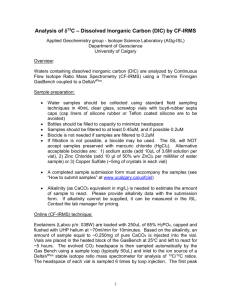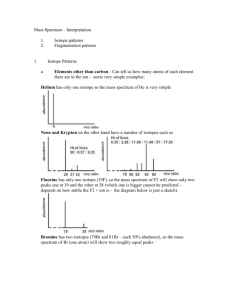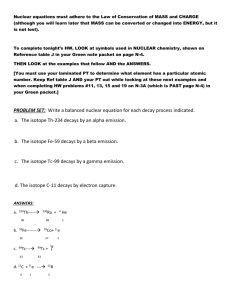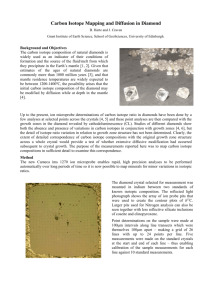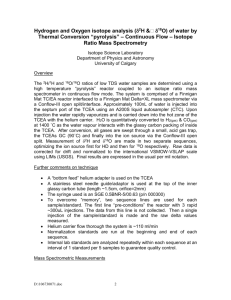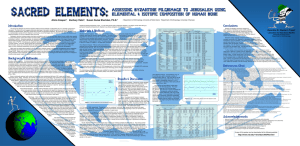2014 Papcastle report Isotopes
advertisement
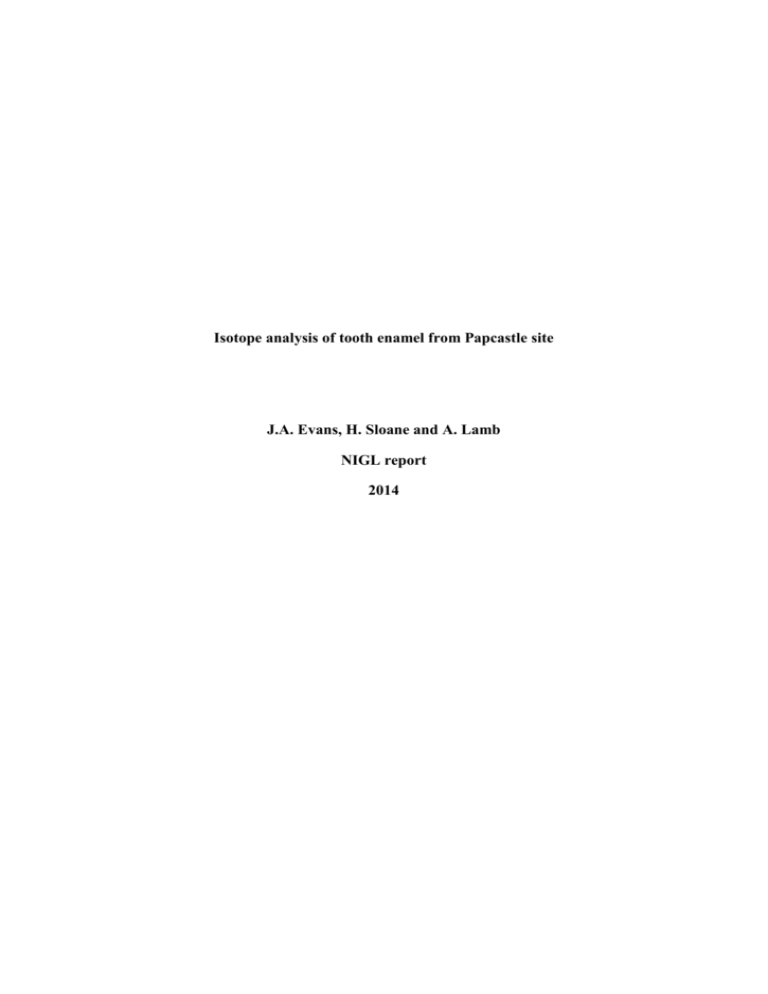
Isotope analysis of tooth enamel from Papcastle site J.A. Evans, H. Sloane and A. Lamb NIGL report 2014 Introduction A tooth enamel and bone sample from Roman aged male was submitted to NIGL for isotope analysis by Mr Don O’Meara. Methodology. Preparation of tooth enamel for Sr isotope analysis In a clean laboratory, the samples were first cleaned ultrasonically in high purity water to remove dust, rinsed twice, put in di-ionized water on a hotplate at 50°C for an hour and rinsed twice and then dried. They were then weighed into pre-cleaned Teflon beakers. The samples were mixed with 84Sr tracer solution and dissolved in Teflon distilled 8M HNO3. The samples were converted to chloride using 6MHCl and strontium was collected using Dowex resin columns. Strontium was loaded onto a single Re Filament following the method of (Birck, 1986) and the isotope composition and concentrations were determined by Thermal Ionisation Mass spectroscopy (TIMS) using a Thermo Triton multi-collector mass spectrometer. The international standard for 87Sr/86Sr, NBS987, gave a value of 0.710250 ± .000006 (n=8, 2) during the analysis of these samples. Blank values were in the region of 100pg. Data are presented below. The chemical preparation and isotope analysis of oxygen in structural carbonate For the isotopic analysis of phosphate carbonate oxygen approximately 3 milligrams of prepared enamel was loaded into a glass vial and sealed with septa. The vials are transferred to a hot block at 90°C on the GV Multiprep system. The vials are evacuated and 4 drops of anhydrous phosphoric acid are added. The resultant CO2 was collected cryogenically for 14 minutes and transferred to a GV IsoPrime dual inlet mass spectrometer. The resultant isotope values are treated as a carbonate. 18O is reported as per mil (‰)(18O/16O) normalized to the PDB scale using a within-run calcite laboratory standard (KCM) calibrated against SRM19, NIST reference material and were converted to the SMOW scale using the published conversion equation of (Coplen, 1988): SMOW=(1.03091 x 18O VPDB) +30.91. Analytical reproducibility for this run of laboratory standard calcite (KCM) is 0.09‰ (1 σ, n=6) for 18OSMOW and ± 0.04‰ (1s, n=6) for 13CPDB. The apatite carbon value (δ13C(ap) ‰ VPDB) is converted to the equivalent collagen values (δ13C(coll) ‰ VPDB ) using the equation of O’Regan et al 2008. The carbonate oxygen results 18OSMOW(c) are converted phosphate values18OSMOW(p) using the equation of Chenery et al 2012: (18OSMOW (p) = 1.0322*18OSMOW (c) – 9.6849) and these are converted to drinking water using the equation of (Daux et al., 2008) ( DW = 1.54*18OSMOW(p) -33.72) . The calculation of drink water values involves considerable uncertainties (Pollard et al., 2011) and the values should be used as guidance. Collagen Extraction and C & N analysis Collagen was extracted following the method of (Brown et al., 1988) and M.P. Richards (pers. com.). Approximately 0.5-1.0g of each bone was cleaned thoroughly in distilled water and placed in polypropylene test tubes with 8 ml of 0.5 M HCl in the fridge for at least 48 hours to demineralise. The demineralising solution was discarded and the remaining solid collagen was rinsed 3 times in deionised water, placed into glass test tubes and solubilised in a solution of pH3 HCl at 70ºC in a hot block for 48 hours. The solutions were filtered using an 8μm Ezze filter to remove solids before freeze drying. Two aliquots from each collagen sample were weighed into small tin capsules for analysis. Analysis of carbon and nitrogen isotopes was by Continuous Flow Isotope Ratio Mass Spectrometry (CFIRMS). The instrumentation is comprised of an Elemental analyser (Flash/EA) coupled to a ThermoFinnigan Delta Plus XL isotope ratio mass spectrometer via a ConFlo III interface. δ13C and δ15N ratios were calibrated using an in-house reference material M1360p (powdered gelatine from British Drug Houses) with expected delta values of –20.32‰ (calibrated against CH7, IAEA) and +8.12‰ (calibrated against N-1 and N-2, IAEA) for C and N respectively. The 1 reproducibility for mass spectrometry controls in this batch of analysis were 15N = ± 0.06‰ and 13C = ± 0.07‰. The results are given below. Results Sample Sr ppm 87 86 Sr/ Sr δ13C(ap) ‰ VPDB δ13C(coll) ‰ VPDB δ18OC ‰ VSMOW δ18OP ‰ VSMOW drinking water estimate RHB-B 125 72.56 %C 0.71093 C/N at %N 32.4 -10.79 11.1 3.4 -17.1 d13C PDB -19.5 +27.49 18.7 -4.9 d15N AIR 11.2 The data provide no evidence that this individual is not of local origin. Both the strontium and oxygen isotope composition from the tooth enamel of this individual is consistent with a childhood spent in the Lake District. These values are not unique and so these results do not rule out other areas with similar characteristics. The oxygen isotope value of δ18OP ‰ = 18.7 is central to the range of value from the western, higher rainfall area of Britain (Evans et al 2012). The rocks that crop out in the Lake District could generate higher values in the biosphere (Evans et al 2010) but such values are modified by high rainfall and proximity to the coast, so the strontium isotope composition of 0.71093 consistent with a Lake District origin. The carbon and nitrogen isotope analysis the bone reflect an adult diet that was typical of British individuals and plots within the dietary field of Roman individuals from Britain (Chenery et al 2010.) We suggest this individual was of local origin. References Birck, J. L., 1986. Precision K-Rb-Sr Isotopic Analysis - Application to Rb-Sr Chronology.Chem. Geol. 56, 73-83. Brown, T. A., Nelson, D. E., Vogel, J. S., and Southon, J. R., 1988. Improved collagenextraction by modiefied Longin method. . Radiocarbon 30, 171-177. Chenery, C., Müldner, G., Evans, J., Eckardt, H., Lewis, M., 2010. Strontium and stable isotope evidence for diet and mobility in Roman Gloucester, UK, J. Arch Sci. 37, 150-163. Chenery, C. A., V. Pashley, A. L. Lamb, H. J. Sloane and J. A. Evans (2012). "The oxygen isotope relationship between the phosphate and structural carbonate fractions of human bioapatite." Rapid Communications in Mass Spectrometry 26(3): 309-319. Coplen, T.B., 1988. Normalization of oxygen and hydrogen isotope data., Chem. Geol. 72, 293-297. Evans, J. A., J. Montgomery, G. Wildman and N. Boulton (2010). "Spatial variations in biosphere Sr-87/Sr-86 in Britain." Journal of the Geological Society 167(1): 1-4.Evans, J. A., C. A. Chenery and J. Montgomery (2012). "A summary of strontium and oxygen isotope variation in archaeological human tooth enamel excavated from Britain." Journal of Analytical Atomic Spectrometry 27(5): 754-764 O’Regan, H.J., Chenery, C., Lamb, A., Stevens, R., Rook, L., Elton, S.E., 2008. Modern macaque dietary heterogeneity assessed using stable isotope analysis of hair and bone., J. Hum. Evol. 55, 617-626. Pollard, A.M., Pellegrini, M., Lee-Thorpe, J.A., 2011. Technical Note: Some observations on the conversion of dental enamel 18O values to 18OW to determine human mobility, American Journal of Physical Anthropology 145, 499-504. Muldner, G. And Richards, M.P. 2007 Stable isotope evidence for 1500 years of human diet at the city of York, UK. American Journal of Physical Anthropology 133: 682-697. Contact. Don O'Meara Environmental Specialist Wardell Armstrong LLP Cocklakes Yard Carlisle Cumbria CA4 0BQ Tel: 01228 564820 Fax: 01228 560025 www.wardell-armstrong.com




